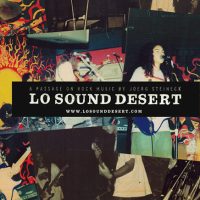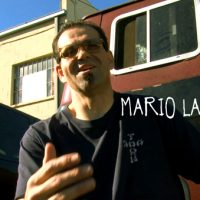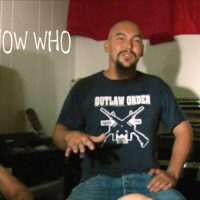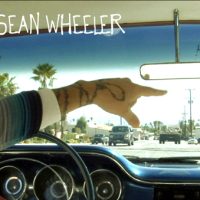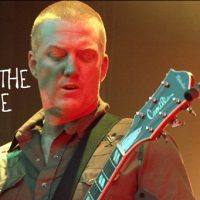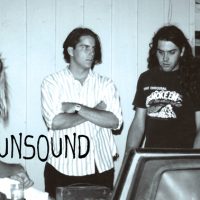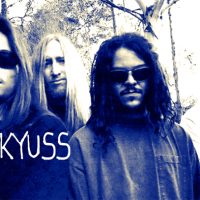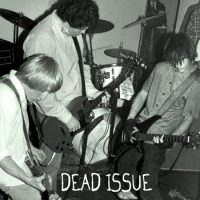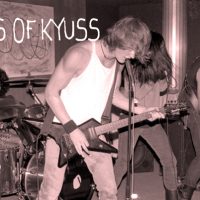
By Rich Henrich
It all started with a drum beat. Then another and another. Centuries would pass but the ancient winds would sound again. The sand was blinding but the vision was clear. Make music not rules. And so it began, the creation of a sound, a scene and a sub-culture that still rages near and far. This is the story of desert rock and the minds behind a movement that would shake the world beat by beat along the 33rd parallel, the same parallel of the Bermuda Triangle and the Egyptian Pyramids. Coincidence? We think not! Desert Rock Lives!
On January 31st, the highly anticipated SNEAK PREVIEW of Lo Sound Desert followed by concerts with several of the bands featured in the doc will take place at The Hood at 6pm. This will sell out. The event is sponsored by CV Weekly and Buzz Factory.
I interviewed the Berlin filmmaker, Joerg Steineck, director of “Lo Sound Desert,” the documentary about the Californian desert punk rock scene that generated, Kyuss and Queens Of The Stone Age.
The film provides an intimate view on the scene’s past and progress, narrated entirely by the main protagonists: the musicians.
CVW: What’s your doc about?
JS: LO SOUND DESERT explores the origin of a specific sub-genre of underground rock music and its spreading variations until today.There’s a whole bunch of interchangeable terms that try to catch this genre’s attitude – call it Stoner or Desert Rock, but it’s just pure heavy music, that got its origin from punk and long time jams.
CVW: Were you able to figure out when this sound started?
JS: What basically started in the early 80’s in some suburban garages in a place called Coachella Valley, in the middle of the desert, was more than a new style of heavy music.
In a way it never appeared completely or reached an extreme popularity like simultaneously grown, but disproportionately hyped and commercialized Grunge in the late 80’s.
CVW: Whose perspective is this documentary coming from?
JS: Lo Sound Desert is narrated by some of the main protagonists:
Josh Homme, Mario Lalli, Alfredo Hernandez, Scott Reeder, Nick Oliveri, Chris Cockrell, Zach Huskey (members of bands like Kyuss, Queens Of The Stone Age, Across The River, Yawning Man, Fatso Jetson, Mondo Generator, Dali’s Llama, Half Astro, Vic Dumonte’s Persona Non Grata, Slo Burn, Unida, You Know Who…).It also features members of bands like Fu Manchu and Nebula.
CVW: Will we see the real stories behind the scenes?
JS: They lead us through unconditioned rehearsal garages in Southern California, smoked-up European backstage rooms and wasteland venues in the nowhere, – silent witnesses of legendary ‘Generator-Parties’.
CVW: Who has been most helpful to you in the process of this doc?
JS: Mario & Larry Lalli, Josh Homme, Brant Bjork, Scott Reeder, Nick Oliveri, Alfredo Hernandez, Sean Wheeler, Zach Huskey and everyone.
CVW: Why did you want to make a documentary on the Desert Rock scene?
JS: I listened to a band named Kyuss when I was a teenager. That was my first connection to desert music. Before I started working on the film, I got in contact with some folks from the desert to shoot a music video.At that time I was studying in San Diego, CA, and had just vague knowledge about that scene,so I figured it would be a good start to learn more by just doing it, driving to the desert, meeting people.The rest happened naturally.
CVW: How do you define “The Scene?”
JS: I’m not sure if there is A scene per se. It’s not like Seattle, where a lot of bands sounded the same. It’s more that the desert scene consists of varieties in music and styles. It’s a pool of differences.
It’s not necessarily a scene built up by choice. In the beginning it was more that isolation factor that bound together:small suburban communities surrounded by a vast wasteland.But the outcome would be people who are inspiring each other by what they’re doing: entertaining themselves.And size-wise it was never more than 200.
CVW: Who are the originators, the creators and innovators of this sound that comes from the Desert?
JS: Ever since people have lived in the desert, they have been having parties and finding ways to entertain themselves. One of the bands from the 80s desert scene that went in a more rockish, jammier direction was Across The River. Mario Lalli, Scott Reeder, Alfredo Hernandez, Mark Anderson.These guys were a lot of people’s main influence and they injected finesse into punk rock.They opened up doors for more artistically relevant music. Also, Mario is not just a great musician, he’s also very forward-thinking. Some of his great talents are to organize events and to motivate people to do something, to be creative. He has a huge impact on what happened in that scene.
CVW: What allowed this music to take shape in Coachella Valley?
JS: The region, the natural surroundings themselves, but also some special characters, like Mario, bringing it all together.”Do it yourself” is sometimes a burden but in general definitely a good way to get the creative juices flowing.The need for some cultural distraction was pretty high, for teenagers there was less than nothing to do except for wait until they grew old enough to get a car and leave the desert. There had to be an outlet to relieve pubertal stress, but before that everything had to be built from nothing.This ultimately led to the final step of going out into the desert, far away from all the narrow-minded authorities, to have so-called generator parties,where people would meet to jam, hang-out, skate, party, have a good time. From there nature itself becomes more relevant in terms of creative proceeding and developing.
CVW: Even after the decline in popularity in the U.S., Europe and AU, NZ still embrace this sound. Why is this? What is the difference in audiences in the U.S and abroad?
JS: There’s a difference in perspective of what the term ‘desert rock’ means or how big the audience actually is. Europeans have a different definition than people from the desert themselves.If you ask a general European rock music fan who has heard the term “Desert Rock”, he/she would probably say: Kyuss or Queens Of The Stone Age.”Desert Rock” to Europeans probably means a specific sound that paints a picture of the surroundings but isn’t necessarily made in those surroundings themselves.And to be honest, compared to all the mainstream genres, the little family of psychedelic music lovers is quite clear.Even if there are small festivals popping up like the Desertfest in Berlin or Stoned From The Underground in Erfurt, Germany, it’s still underground and it will stay like this because that’s what it’s meant to be.
CVW: What surprised you in the process of making this documentary from a technical stand point?
JS: I’d like to skip this question because I’m not exactly sure what you mean.Instead I want to tell you why I chose DIY…Before I finally decided to make this film all by myself, which was a tough but necessary decision to get this done the way I wanted it to be,
I tried working together with different media companies. But the result would have been that the original idea to make a film specifically about the desert scene drifted in a more commercial direction, with a bigger focus on bands like Kyuss and QOTSA. They offered financial and general production support, but also intended to tell me how to do it, how to beef up the look, how to make it more mass compatible.
So I figured – the whole scene is based on DIY, so why shouldn’t the film be?Stylistically I guess I had a clear vision from the beginning – I didn’t see a reason for using the priciest camera equipment with the sharpest lenses when the whole story takes place in the desert, full of sand and dust. I wanted it to look rather grindy and distorted to express the general punk rock vibe and atmosphere of that time. High-gloss kills imagination in general but here – making it look “pretty” would have been a definite stylistic mistake.
CVW: Do you think there is something special to a place that allows for creation, like the desert? What factors need to be present for something new to form from the ethers?
JS: I think the desert is a very abstract place. For people who don’t live close to anything like this, it even appears unreal or surreal. It’s vast and it seems like nature completely removed all embellishment there. I mean, if you go through a forest or the fields and remove the functional aspect of all living things you will eventually find some rather fancy accessories that mother nature provided, seemingly just for keeping us entertained. The desert on the other hand can be very pure: There will only be a few chollas and tumbleweeds and a lot of sand for miles, and you will be completely exposed to some strange feeling that can be defined as truth if you will. Not for nothing religions and spirituality itself grow from desert regions. It’s a matter of loneliness and quietness your mind has to cope with.
And if there’s only basic elements between you and your creativity, like surviving or dying in a very abstract but literal sense in this context, you will probably experience a different approach to your inner processes, or what moves you. And going out there, making music might be a more natural approach than going into the studio or rehearsal room to jam.
The music style that people from the desert rock scene were mainly influenced by in the early 80’s was punk rock. And that’s the influence from outside.But when you grow as musician or artist in general you get shaped more by your closer, your direct influences rather than only of what comes in through the media.That’s when people started to expand their musical range and putting less emphasis on the visual performance. They’d go out into the desert and spend their time with their friends … and jam. Everything else comes naturally.
Hard rock or punk that was played by desert bands was definitely not a new invention, but it definitely has its desert coloring.
CVW: Where will this music evolve in the next decade?
JS: Psychedelic Rock? That’s hard to foresee actually. It might bob up and down like heavy metal for a few more years with variations to come, but I’d say for sure it will never become mainstream.
CVW: What was the most fun you had during this production?
It was definitely not clearing music rights or waiting for promised original footage that would never come!
But there are many different fun facts that you experience when you do everything by yourself as filmmaker.
Editing can be fun, animating and creating the film’s art too, and so is filming interviews with people. To be honest, this was the toughest DIY thing I’ve ever experienced. I felt pretty relieved when I recognized this would come to an end after almost 10 years, so I can finally move on and concentrate on new projects.
Please check out the film’s website and facebook pages at: www.losounddesert.com and www.facebook.com/losounddesert
The screening of LoSound Desert will take place on Saturday, Jan. 31st with doors opening at 6pm and Herbert performing at 6:30. Movie starts at 7pm sharp. After party with the following bands: Blasting Echo 8:35/Hellions 8:55/War Drum 9:15/Hot Beat Pussy Fiend 9:35/Dali’s Llama 9:55/Family Butcher 10:15/Fatso Jetson 10:35/You Know Who 10:55/Nick Oliveri’s Uncontrollable 11:15/House of Broken Promises 12:35. All ages until 10pm. $10.00 Cover. This show will sell out.
From the Publisher: I asked a few of the desert rock legends that are in the movie to answer the questions below and share their thoughts….
CVW: What does being part of the desert rock scene means to you? What impact do you feel Joerg doing this movie has on the desert music scene and how do you feel about being part of the movie?
Scott Reeder: (Across The River, Kyuss, The Obsessed, Unida, Goatsnake, Sun & Sail Club, Butcher, The Freeks, Ten East, Yawning Sons, Fireball Ministry, Dead Issue, Target 13, Subservice, Nebula)
It was nice to read in The Desert Sun that Joerg considers my old band from the mid 80’s, Across The River, to be the major influence of how this desert rock thing came to be. After that, I was the first person from our little scene to play overseas in 1991 during my time with The Obsessed. When I joined Kyuss, I bugged the guys for a couple of years about getting over to Europe – I knew we’d kill it there, too!
Some of the people who’d helped The Obsessed overseas also jumped right in for the Kyuss thing! I’m stoked for all the desert musicians that have been able to get over there since those days, and proud of Josh, after Kyuss, for really breaking it out on such a huge scale with Queens Of The Stone Age! He’s brought lots of attention and interest back to our desert, which has benefitted lots of musicians around here, whether or not they realize it. I really appreciate Joerg for preserving some of the memories of our scene’s history with this film.
Gary Arce: (Yawning Man, Ten East, Fatso Jetson, Sort of Quartet, Oddio Gasser)
I guess if I were to have a quote it would be…I was fortunate enough to have friends that played music and were into the same mindset, which is: “the rules are no rules”. We were punk rock kids who embraced everything musically. Bands like Across the River, Inglenook, Dotted Swiss, Sons of Kyuss and Yawning Man for me were the original desert bands that set the tone for what’s happening today.
Mike Pygmie: (Melodious Pygmies, The Agents, Brothers from Different Mothers, Invitro, The Whizards, You Know Who, John Garcia, Mondo Generator, Waxy, Brant Bjork and the Operators)
It has heavily influenced the way I play and even think about music because it’s a community where rather than trying to sound a certain way to fit in you get more respect for being yourself. No rules Rules!
I can only imagine what impact it will have. I know that discovering new bands is incredibly exciting to me and I hope that a lot of people get exposed to some killer bands through the film. I’m super stoked to be involved in it because I’m really proud of our scene. Some of my favorite bands ever are from right here and are some of my best friends as well.
Ian Taylor: (Unsound, Mondo Generator, Furious IV, The Adolescents, Chump, Ian Taylor & The Guilty Party)
It’s strange to hear that people are talking about the shows and the parties we threw over twenty years ago, but I’m OK being associated with a pretty impressive group of musicians. It’s rad that most of the people we started out jamming with as kids are still plugging away today and touring the world playing their songs!
Maybe it will shine a light on a new generation of bored kids with guitars. Who knows, but mostly it’s just cool that somebody is sharing the songs and stories with the rest of the world. Better late than never right. Hah!
There have been many interviews over the years and it looks like Joerg might be the first one to pull this off. It must have taken a lot of patience, time and money to get this crazy cast of characters to sit down for a minute… Cheers to Joerg! (If he doesn’t make us look like assholes, that is.)
Jeff Bowman: (Unsound, Mighty Jack, Waxy and Nick Oliveri’s Uncontrollable)
I am really grateful to have experienced that incredible era of desert music, both as a listener and a musician. It was a scene of doers…of troopers: An army of kids starving to be on one side or the other of the art and expression…ballsy enough to endure what it took to make it all happen. The music was great, the vibe was right and to this day the memories, lore and respect for the whole scene follows every one of us who were a part of it…whether we’ve “made it out of the desert” or not.
I’m excited that this film is being released and will shed even more light on the great bands and tenacious people that took part in creating this desert scene…A scene that has become a globally recognized genre. There was no template here, no precedent, and no real support from the outside. It was built from the sand up by our own Mario Lalli and a few hundred of his devoted friends. It’s a heroic true story and I expect that is exactly what this film will capture and share with thousands around the world.
Zach Huskey: (Dali’s Llama, Primordial Blues, The Hick Ups, Hot Beat Pussy Fiend)
I’m just happy that I grew up in a place where the kids encouraged original music (in all genres), and that I was a musician and a songwriter of original music in that environment. What “desert rock” means to me – it’s about creating original “outsider” music with the basis being punk rock and other underground unique musical styles, such as blues, 70’s hard rock, free jazz, Americana with a big dose of 60’s psychedelic garage band sounds, etc, etc, etc. It’s about freedom. It’s about being a music fan and it’s about old and new friends, and about creating the music you want to create. It was about creating a place where the few bands that existed could have the freedom to express themselves. It was about creating, or finding places where we could play our original music.
Hopefully bands from the desert will get more exposure and hopefully that helps the bands in the long run. Erica and I like and respect Joerg. He did this movie because he’s a fan of desert rock and he spent a long time filming it. I spent quite a bit of time with him. Taking him out in the desert “snake hunting,” jeeping and just talking about the old days before generator parties, and how things changed through the years. Joerg asked if I would record some soundtrack music, which I did with Scott Reeder up at The Sanctuary. I hope this documentary does well. He should be proud.
Tony Tornay: (Ink Cause, Solarfeast, Fatso Jetson, Deep Dark Robot)
I’m not sure what being a part of the “desert rock scene” means to me, I just know that I am proud of what a bunch of bored kids created with a little ambition and a lot of volume. When I was a kid I was jealous of people in LA or San Diego or any other major city, they had all the music stores, venues, publications… We had nothing. It took me a few years to realize how lucky we were to be able to start with a blank slate and create something for ourselves that was completely for us, by us, and without any rules.
Jack Kohler: (War Drum, Waxy)
Desert rock is a genre that’s spread all over the world, and War Drum’s music is so drawn from the desert around us. It’s incredible to me that it’s gotten to where it has, and just as important to keep it alive and thriving. There’s a pulse in this desert, and we all get together for things like this to honor that tradition.
Joerg’s interest and passion for Lo Sound Desert breathes life into the desert music scene. People have been waiting for a DECADE for this film to be seen, and it’s brought unity amongst old and new friends alike. We sat with Joerg in Berlin and gave him our outlook on the desert scene, and were honored that he included our music in the film. Hats off Joerg!
-
![losounddesert1]()
-
![Zach Huskey]()
Photo Still From "Lo Sound Desert" Courtesy of Joerg Steineck
-
![Mario Lalli]()
Photo Still From "Lo Sound Desert" Courtesy of Joerg Steineck
-
![You Know Who]()
Photo Still From "Lo Sound Desert" Courtesy of Joerg Steineck
-
![Sean Wheeler]()
Photo Still From "Lo Sound Desert" Courtesy of Joerg Steineck
-
![QOTSA Josh]()
Photo Still From "Lo Sound Desert" Courtesy of Joerg Steineck
-
![Unsound]()
-
![Kyuss]()
-
![DeadIssue]()
-
![Sons of Kyuss]()
-
![AcrossTheRiver]()


































